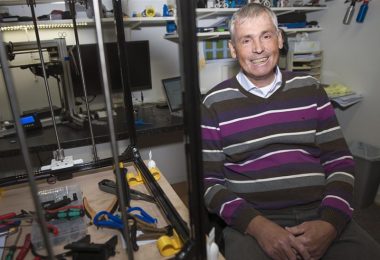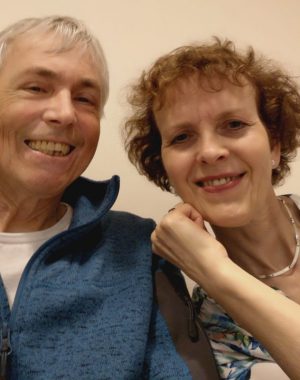Tinker, Tailor, Scleroderma: Staying Positive in the Netherlands

Joep Welling’s story is among those featured in More Than Scleroderma, an initiative by European pharmaceutical company Boehringer Ingelheim to showcase how various people have adapted to life with the disease. A video of Joep for the project shows him using a 3D printer to fabricate tools that help him with daily activities that have been hampered by scleroderma.
Joep, 66, was diagnosed with the disease 11 years ago. Now retired from his career as an infection control nurse and adviser to general physicians and pharmacies, Joep lives in Ede, Netherlands, with his wife, Hermien. He is active in the scleroderma community and enjoys numerous hobbies, including cycling.
Impressed by his positive attitude, I tracked Joep down, and we spoke by phone. Excerpts of our conversation follow, with light editing for clarity.

Joep Welling uses a 3D printer to make various tools to assist him with everyday activities that are difficult with scleroderma. (Courtesy of Joep Welling)
DCW: What is your involvement with the scleroderma community?
JW: Since 2010, I [have been] involved in research as a patient research partner. In 2011, I was active as a board member of the National Coalition of Dutch Patients. In 2012, I was chosen as president for that organization. In 2015, I stopped due to physical problems like weight loss and other effects of scleroderma.
In 2013, I was invited to be an adviser for SPIN [Scleroderma Patient-centered Intervention Network]. I was active for FESCA [Federation of European Scleroderma Associations] from 2015 until 2020 as a board adviser for research.
In your video for the More Than Scleroderma project, you mentioned that you think about the things you can do, not the things you can’t. Would you expand on that?
When you stay positive, you see [fewer] hurdles and more options, and it makes you feel better, too. After my diagnosis of scleroderma, it was for me, like everyone else who gets that diagnosis, a heavy block on my shoulders. You need to find a way to cope with that. Just by staying positive, I found out about people with scleroderma and the way the treatments are organized. I now often say, “Know your body, then you can take care of it.”
How do you manage type 1 diabetes and scleroderma in your daily life? How does it affect your physical routines?
I see it as an extra hurdle to get over. But nowadays, the options are better than when I was diagnosed [at] age 15 with diabetes. I now use a hybrid insulin pump with a glucose sensor. That helps, but in my case, it [requires] a lot of attention to keep the glucose levels acceptable. My gastrointestinal system is not working so good due to scleroderma.
In the video, you are working with a 3D printer. What are some scleroderma-related items you make and their uses?
I’m happy to be a member of the Boehringer Ingelheim trial advisory board. We were shown the aids they made for opening [medications that come in] blister and bottle packaging. I was not happy about the solution they offered, and at home I got an idea. But the best way to test an idea is to create an example. I sent it to the company and they worked with it, and now it is available for users of Boehringer Ingelheim medication. That gives me a good feeling.
You live in the Netherlands, but have traveled extensively. What similarities and differences have you found between the scleroderma communities in Europe and the U.S.?
I think there is a lot of similarity in people with scleroderma all over the world. We want to let the world know that a rare disease [like] scleroderma exists, and that there is a need for a cure.
You can also see that there is a different attitude in the U.S. and Europe. The options for people in Europe are mostly available but can differ according to the country. When I look in the Netherlands, there is good social security for ill people, and you can get a disability allowance.
I spoke to a group of men during the 2013 Scleroderma Foundation conference. There was a good discussion [about] how men are coping with their illness and feelings. There was a man who said that he needed to continually be employed until his death so he could pay for life insurance for his family. This shows a situation where there is a need for financial support for seriously ill persons all over the world. You still need a good quality of life, even when you are ill.

Joep and Hermien Welling. (Courtesy of Joep Welling)
What priorities should a couple focus on to manage the challenges of scleroderma?
Talk with each other about your feelings [and] options, and when you have kids, inform them that you are stronger together and will live life better as a family.
***
As we say “vaarwel” (farewell) to Joep, let’s follow his lead and “blijf positief, blijf hoopvol” (stay positive, stay hopeful).
***
Note: Scleroderma News is strictly a news and information website about the disease. It does not provide medical advice, diagnosis, or treatment. This content is not intended to be a substitute for professional medical advice, diagnosis, or treatment. Always seek the advice of your physician or other qualified health provider with any questions you may have regarding a medical condition. Never disregard professional medical advice or delay in seeking it because of something you have read on this website. The opinions expressed in this column are not those of Scleroderma News or its parent company, BioNews, and are intended to spark discussion about issues pertaining to scleroderma.








Comments